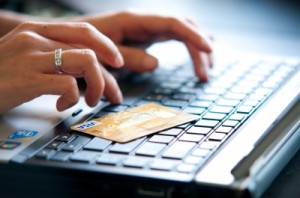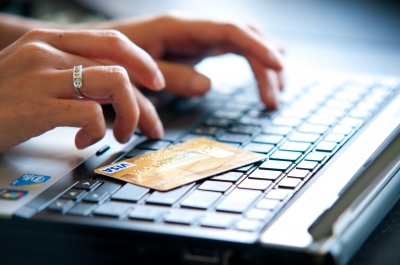Online banking is extremely convenient. But being able to control accounts from home has some associated risks of managing financial information online. What are some of the ways that you can protect yourself while banking online and processing payments with credit cards?
Access Accounts from Secure Networks

Another type of security is necessary while the signal is on the “Internet” even if you have a wire (no WiFi) connection. The way the web works your signal is passed from node to node until it gets to its destination. This could result in several “hops” before getting there and at each of those hops there is the potential for some sort of hacking. This is why you need a secure “tunnel” from your computer all the way to the end site. Once inside the tunnel, the individual servers along the way can’t see your data. Most financial websites provide this type of tunnel automatically on their transaction page. A secure “tunnel” connection usually has a little “padlock” icon displayed (depending on the browser you are using). The web address (URL) will also be “https://” rather than just “http://“. In Internet Explorer the padlock is at the en of the URL field and it is closed when you are inside the tunnel. Also the field changes to green for a secure connection and next to the Padlock they list the company name of the owner of the SSL security certificate. Other browsers will handle this a bit differently. You should always check that these exist before entering any sensitive financial information. A site that doesn’t provide this type of security should be considered very suspect. But not every page on the site may be secure it may only be on the page that actually asks for your credit card information.
Change Passwords Frequently
In addition to choosing a secure password that won’t be easily guessed, it’s important to change the passwords frequently. Changing the password every three to six months and using dashes or symbols, plus combinations of letters and numbers in the password can help to reduce the chances that the account is going to be compromised. A good way to make your password more secure while at the same time memorable is to use special characters instead of letters and make it at least 8 characters long. So if I chose the word “password” as my password I would write it like this P@$$word123, notice that I also added a few numbers at the end. So that password is now 11 characters long, has a Capital letter, 3 special characters, 3 numbers and is still easy to remember. Another key is to not use the same password for every site. After all if someone hacks your Facebook account you don’t want them to discover the password you use for your bank account. A good way to store your passwords is in a special program like RoboForm or Norton Safe Web, that way you can have an entirely different password for each use and not worry about having to remember them all. Often these programs will have a random password generator that will be very long, hard to decrypt and almost impossible to remember (but that’s why you have the password keeper).
Protect Yourself Online- Shop Smarter
There are hundreds of thousands of ways and places to enter your credit card information while shopping online. Shopping smart and ensuring that the service or products being purchased are being done so from a reputable online source is essential in keeping yourself protected. Look for the secured icon in the web browser before entering any financial information.
Services that appear similar to log-in information for your financial institutions, or phishing emails that prompt you to confirm your credit card account number with other identifying pieces of information should be reported to the email provider, and no information should be entered. Also be sure to use a credit card rather than a debit card. Credit cards have a fraud limit usually of as low as $50 so when your statement comes you can dispute the charge and not have any money out of pocket. But a debit card can clean out your account and then you have to fight to get the money back! And since it is your money rather than the bank’s they aren’t as motivated to get a timely resolution.
Use a Temporary Credit Card Number
Some financial institutions are allowing customers to make use of temporary generated credit card numbers while shopping online. Similar to the online payment services that can be used to mask the original credit card number while shopping, you can shop securely knowing that the original credit card number is not going to be found anywhere within the transaction that is being made.
But recently some of the primary providers have changed their systems trying to make them more secure and have made them so secure it is almost impossible to use them i.e. requiring you to verify your identity and then get a call back to your phone of record etc. etc. One BIG advantage to one time use virtual numbers is that they cannot be used again to send you goods and services you didn’t ask for. For instance, when you buy a ’1 month supply’ of an item from some vendors you sometimes receive another ‘month’s supply’ every month billed to your credit card. Getting these charges to stop is often very difficult. With virtual numbers that can never happen. The key to getting the most security is to be able to set both a maximum amount and a time limit. By setting both the virtual credit card can improve your security.
How can you get a temporary credit card number? Look for free online payment processing services, or contact your financial institution to see if the service is available. If it isn’t, look for low cost prepaid credit cards to complete online transactions without the identifying financial information.
Monitor Your Statements
When credit card and bank statements arrive in the mail, don’t immediately put them into the pile of things to be shredded. Have a look through the statements and monitor the transactions that are being completed. Do this monthly and ensure that the transactions being completed are ones that you have initiated. Often, small amounts of fraud or mistakes that occur in the bank account or through the credit card aren’t corrected. Staying on top of the finances will ensure that you come out on top, and that you can quell things like identify theft before they become detrimental to your personal financial records.
While you are at it eliminate paper statements altogether and just get electronic updates that way there is no paper to shred (you are shredding any paper with your financial numbers on it, right?).
Check Your Credit Report
One of the most important parts of protecting your financial identity and online bank accounts and credit cards is to monitor your credit report. There, you’re going to be able to determine whether there are any new accounts that have been opened, suspicious activity that might have taken place and whether there are any new balances that are being reported.
Use these tips while banking online, shopping and using the credit card for everyday purchases to ensure that you maintain control of your finances and protect yourself while you are shopping online.
See Also:
- 10 Ways To Ensure Online Credit Card Security
- Online Banking
- Choosing The Best Bank
- Savings and Banking
- Dollars and Cyber-Sense: Tools to Help You Track Your Personal Finances Online
- Why I Love Shopping Online
Resources:
Image courtesy of sixninepixels / FreeDigitalPhotos.net

